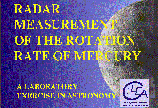

 |
Required Windows SoftwareThis is a zip file that contains an .exe file that will install itself when you run it on your computer.
|
||
| Purpose: To illustrate the measurement
of the rotation rate of a planet using the Doppler shift of a returning
radar pulse.
Students are given control of a simulated radar telescope. They point it toward Mercury and send off a narrow pulse of radio waves. During the time required for the pulse to go to Mercury and return (10 to 20 minutes, depending on the aspect of Mercury), the screen displays an animation showing the inner solar system and the position of the wavefront of the pulse and its echo. The received echo, frequency versus intensity, is displayed for 5 time slices, which correspond to echoes from surface elements progressively further from the subradar point. By clicking the mouse cursor, students can measure the Doppler shift from the approaching and receding limbs of the planet, and from this determine (with appropriate geometrical corrections) the equatorial rotational velocity of Mercury. This, in turn, gives the period of rotation of the planet. Students use off- line calculators to reduce the data. The software features on-line data recording, a printing option, and an on-line checker, which tells students if their calculations are "in the ballpark". Options include the ability to speed up the return pulse, reducing the waiting time.
|